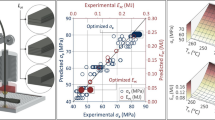Abstract
Incremental sheet forming (ISF) is a promising method for forming metal sheets, by which parts can be manufactured without the use of dedicated dies. However, the process has not been widely used for industrial application due to the unsatisfactory service performance of the formed parts. This paper focuses on improving the thickness distribution and mechanical properties (e.g., hardness, yield strength, and tensile strength) through process optimization. The response surface methodology with a Box-Behnken design is used to investigate how different process parameters affect the thickness thinning and mechanical properties. A set of experiments with 15 tests for pyramid-forming process is performed, and three parameters including step-down size, sheet thickness, and tool diameter are considered. The results show that the maximum thinning rate is lower with larger step-down size and larger tools. In addition, compared with the initial sheet, the values of hardness, yield strength, and tensile strength have been increased considerably due to the strain hardening. The present work provides useful guidance in improving the product quality formed by incremental sheet forming.
Similar content being viewed by others
References
Emmens WC, Sebastiani G, Van den Boogaard AH (2010) The technology of incremental sheet forming—a brief review of the history. J Mater Process Technol 210(8):981–997
Li Y, Chen X, Liu Z, Sun J, Li F, Li J, Zhao G (2017) A review on the recent development of incremental sheet-forming process. Int J Adv Manuf Technol 92:2439–2462
Raju C, Haloi N, Sathiya Narayanan C (2017) Strain distribution and failure mode in single point incremental forming (SPIF) of multiple commercially pure aluminum sheets. J Manuf Process 30:328–335
Ambrogio G, Filice L, Fratini L, Micari L (2004) Process mechanics analysis in single point incremental forming. Columbus. Ohio,USA:AIP Conference Proceedings 922(712): 922–927
King JM, Allwood GPF, Duflou J (2005) A structured search for applications of the incremental sheet-forming process by product segmentation. Proc Inst Mech Eng B 219(2):239–244
Essa K, Hartley (2011) An assessment of various process strategies for improving precision in single point incremental forming. Int J Mater Form 4(4):401–412
Meier H, Magnus C, Smukala V (2011) Impact of superimposed pressure on dieless incremental sheet metal forming with two moving tools. CIRP Ann Manuf Technol 60(1):327–330
Bambach M, Taleb Araghi B, Hirt G (2009) Strategies to improve the geometric accuracy in asymmetric single point incremental forming. Prod Eng 3(2):145–156
Lu H, Michael K, Li Y, Liu S, Daniel WJT, Meehan PA (2016) Model predictive control of incremental sheet forming for geometric accuracy improvement. Int J Adv Manuf Technol 82(9–12):1781–1794
Kobayashi S, Hall IK, Thomsen EG (1961) A theory of shear spinning of cones. Tran ASME, J Eng Indust 83:485–495
Jeswiet J, Young D (2005) Forming limit diagrams for single point incremental forming of aluminium sheet. Proc Inst Mech Eng B 219(4):359–364
Young D, Jeswiet J (2004) Wall thickness variations in single point incremental forming. Proc Inst Mech Eng B 218(B11):204–210
Kegg Richard L (1961) A new test method for determination of spinnability of metals. J Eng Ind-T ASME 83(2):119–124
Kim TJ, Yang DY (2000) Improvement of formability for the incremental sheet metal forming process. Int J Mech Sci 42(7):1271–1286
Liu B, Daniel WJT, Li Y, Liu S, Meehan PA (2014) Multi-pass deformation design for incremental sheet forming: analytical modeling, finite element analysis and experimental validation. J Mater Process Technol 214(3):620–634
Mirnia MJ, Dariani BM, Vanhove H, Duflou JR (2014) An investigation into thickness distribution in single point incremental forming using sequential limit analysis. Int J Mater Form 7(4):469–477
Li Y, Daniel WJT, Meehan PA (2017) Deformation analysis in single-point incremental forming through finite element simulation. Int J Adv Manuf Technol 88:255–267
Li Y, Daniel WJT, Liu Z, Lu H, Meehan PA (2015) Deformation mechanics and efficient force prediction in single point incremental forming. J Mater Process Technol 221:100–111
Behera AK, de Sousa RA, Ingarao G, Oleksik V (2017) Single point incremental forming: an assessment of the progress and technology trends from 2005 to 2015. J Manuf Process 27:37–62
Tian H, Kang D (2003) A study on determining hardening curve for sheet metal. Int J Mach Tools Manuf 43(12):1253–1257
Nayebi A, Bartier O, Mauvoisin G (2001) Abdi R EI. New methods to determine the mechanical properties of heat treated steels. Int J Mech Sci 43(11):2679–2697
Rojacz H, Mozdzen G, Winkelmann H (2014) Deformation and strain hardening of different steels in impact dominated systems. Mater Charact 90:151–163
Fan G, Li G (2014) Mechanical property of Ti-6Al-4V sheet in one-sided electric hot incremental forming. Int J Adv Manuf Technol 72(5–8):989–994
Jeswiet J, Micari F, Hirt G, Bramley A, Duflou J, Allwood J (2005) Asymmetric single point incremental forming of sheet metal. CIRP Ann Manuf Technol 54(2):623–649
Ambrogio G, Gagliardi F, Bruschi S, Filice L (2013) On the high speed single point incremental forming of titanium alloys. CIRP Ann Manuf Technol 62(1):243–246
Long Y, Li Y, Sun J, Ille I, Li J, Twiefel J (2018) Effects of process parameters on force reduction and temperature variation during ultrasonic assisted incremental sheet forming process. Int J Adv Manuf Technol 97(1–4):13–24
Kim YH, Park JJ (2002) Effect of process parameters on formability in incremental forming of sheet metal. J Mater Process Technol 130:42–46
Funding
This study is financially supported by the National Natural Science Foundation of China (51605258), China Postdoctoral Science Foundation funded project (2016M592180), Postdoctoral innovation project of Shandong Province (201701011), and State Key Laboratory of High Performance Complex Manufacturing, Central South University (Kfkt2017-04).
Author information
Authors and Affiliations
Corresponding author
Rights and permissions
About this article
Cite this article
Li, Y., Chen, X., Zhai, W. et al. Effects of process parameters on thickness thinning and mechanical properties of the formed parts in incremental sheet forming. Int J Adv Manuf Technol 98, 3071–3080 (2018). https://doi.org/10.1007/s00170-018-2469-9
Received:
Accepted:
Published:
Issue Date:
DOI: https://doi.org/10.1007/s00170-018-2469-9




